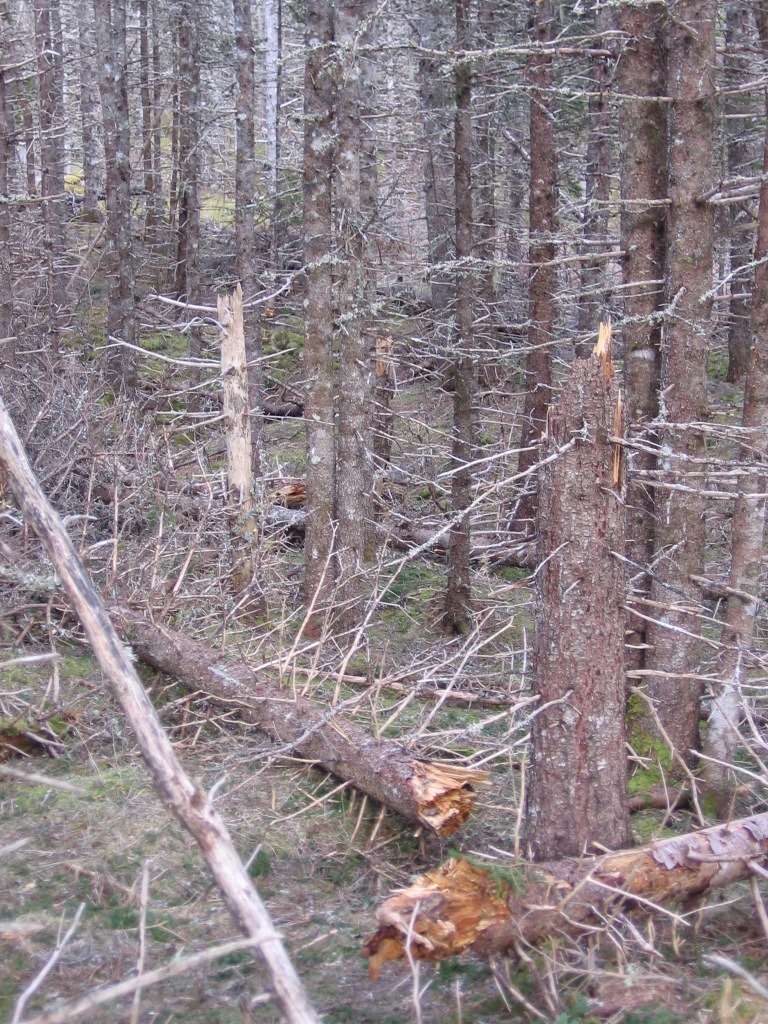I submitted this essay to the CBC Canada Writes contest called Hyperlocal. It was awarded a gold star as ‘Editors’ Pick’ of the day. In grade 2 I was in fierce competition with Cindy Egbert to get the most gold stars for spelling, so I was rather chuffed.
My neighbourhood is a forest on Cape Breton Island, and it is dying. The trees that are my nearest neighbours are dropping dead at an ever faster rate. A walk through the woods reveals the carnage – standing tree trunks ending in exposed jagged shards. The toppled crowns lie strewn on the forest floor or lean against ailing neighbours. When I first walked this trail a dozen years ago, the tall white spruce rising high overhead created a cool shaded passage that felt like a cathedral. Now my cathedral is a graveyard and deadfall blocks the trail used by moose, coyotes, bears and me. Each freshly fractured tree stabs at my heart. And sometimes, when a tree falls in the forest, I hear. A crack like a rifle shot, a thud bouncing off the Highlands and echoing across the pond.
When I look across the pond to the hill, deep conifer green is peppered with the stark grey of the standing dead. The pace of decimation is breathtaking. My towering neighbours are under attack by a bark beetle the size of grain of rice, and they are losing.
This is only the most recent change in my neighbourhood. When this land was reclaimed from the glaciers it gave rise to a mixed Acadian forest of birch and maple, hemlock and pine. Scottish settlers cleared the trees and tried to coax crops from the rocky glacial till, but some fifty years ago they abandoned the hard-scrabble farms for greener pastures. White spruce sprouted like weeds, surrounding old apple trees and concealing the stone root cellars that bear witness to a more domesticated past. Now the spruce trees are growing old, and are, like all the aged – be they tree or coyote, man or moose – more vulnerable to disease and death.
My deceased – and diseased – neighbours are being reclaimed by the forest floor that birthed them. Gravity gradually eases the trunk into the ground as insects and fungi go to work. Moss draws a soft green blanket over the log as it disintegrates into the soil, forming an undulating forest floor. Some seeds sprout on the sunny, well-drained tops of these hummocks while others thrive in the cool shady moisture below. Newly created gaps in the canopy let the sunshine peek in for the first time in decades and birch and maple saplings take root and reach for the sun. The forest succession back to a mixed Acadian forest is underway. But I, alas, will not be alive to see it. I see only this dying. By the time this forest is transformed, my own body, like the spruce, will have returned to the elements. My atoms will disperse into air, water and soil, nourishing new seedlings, inhabiting roots and bark and leaves, cycling through life and death and life again. My neighbourhood is a forest and it is dying. Long live the forest.
by Sue McKay Miller
May 2013




Loved it, Sue! Long live your writer’s observant eye and expressive pen! xo sister Janet
LikeLike
Thanks sister! I learned from the best – you always show me so much about Rocky Mountain flora and fauna when we go for a stroll out there. I look forward to our next visit!
LikeLike
Wonderful writing!
LikeLike